Ramin Nilforooshan
Urinary Tract Infection Detection in Digital Remote Monitoring: Strategies for Managing Participant-Specific Prediction Complexity
Feb 18, 2025Abstract:Urinary tract infections (UTIs) are a significant health concern, particularly for people living with dementia (PLWD), as they can lead to severe complications if not detected and treated early. This study builds on previous work that utilised machine learning (ML) to detect UTIs in PLWD by analysing in-home activity and physiological data collected through low-cost, passive sensors. The current research focuses on improving the performance of previous models, particularly by refining the Multilayer Perceptron (MLP), to better handle variations in home environments and improve sex fairness in predictions by making use of concepts from multitask learning. This study implemented three primary model designs: feature clustering, loss-dependent clustering, and participant ID embedding which were compared against a baseline MLP model. The results demonstrated that the loss-dependent MLP achieved the most significant improvements, increasing validation precision from 48.92% to 72.60% and sensitivity from 27.44% to 70.52%, while also enhancing model fairness across sexes. These findings suggest that the refined models offer a more reliable and equitable approach to early UTI detection in PLWD, addressing participant-specific data variations and enabling clinicians to detect and screen for UTI risks more effectively, thereby facilitating earlier and more accurate treatment decisions.
Evaluating Spoken Language as a Biomarker for Automated Screening of Cognitive Impairment
Jan 30, 2025Abstract:Timely and accurate assessment of cognitive impairment is a major unmet need in populations at risk. Alterations in speech and language can be early predictors of Alzheimer's disease and related dementias (ADRD) before clinical signs of neurodegeneration. Voice biomarkers offer a scalable and non-invasive solution for automated screening. However, the clinical applicability of machine learning (ML) remains limited by challenges in generalisability, interpretability, and access to patient data to train clinically applicable predictive models. Using DementiaBank recordings (N=291, 64% female), we evaluated ML techniques for ADRD screening and severity prediction from spoken language. We validated model generalisability with pilot data collected in-residence from older adults (N=22, 59% female). Risk stratification and linguistic feature importance analysis enhanced the interpretability and clinical utility of predictions. For ADRD classification, a Random Forest applied to lexical features achieved a mean sensitivity of 69.4% (95% confidence interval (CI) = 66.4-72.5) and specificity of 83.3% (78.0-88.7). On real-world pilot data, this model achieved a mean sensitivity of 70.0% (58.0-82.0) and specificity of 52.5% (39.3-65.7). For severity prediction using Mini-Mental State Examination (MMSE) scores, a Random Forest Regressor achieved a mean absolute MMSE error of 3.7 (3.7-3.8), with comparable performance of 3.3 (3.1-3.5) on pilot data. Linguistic features associated with higher ADRD risk included increased use of pronouns and adverbs, greater disfluency, reduced analytical thinking, lower lexical diversity and fewer words reflecting a psychological state of completion. Our interpretable predictive modelling offers a novel approach for in-home integration with conversational AI to monitor cognitive health and triage higher-risk individuals, enabling earlier detection and intervention.
A Markov Chain Model for Identifying Changes in Daily Activity Patterns of People Living with Dementia
Jul 20, 2023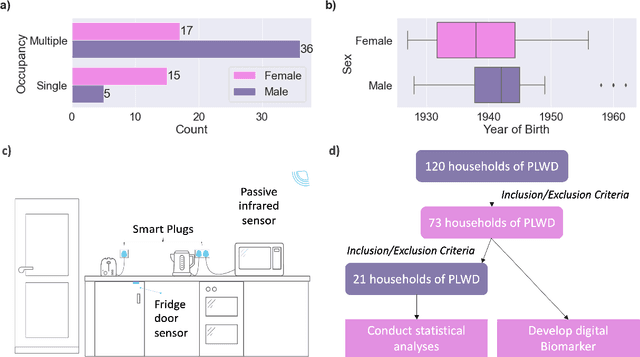
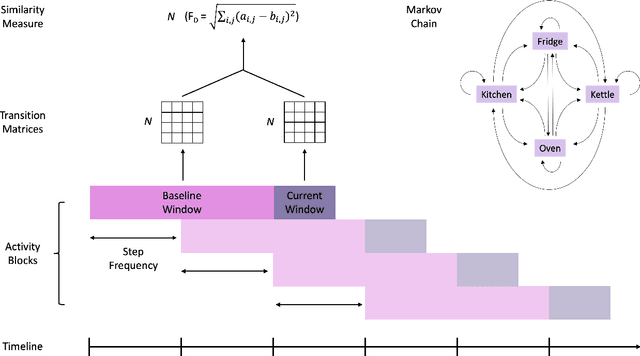
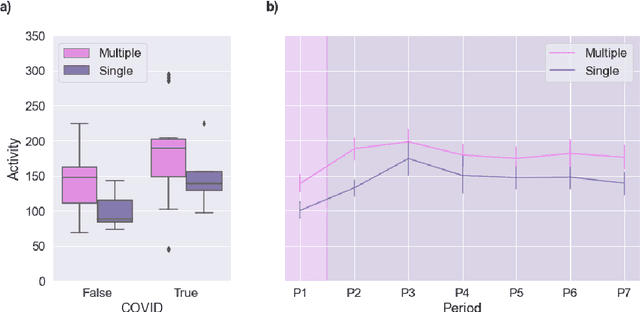
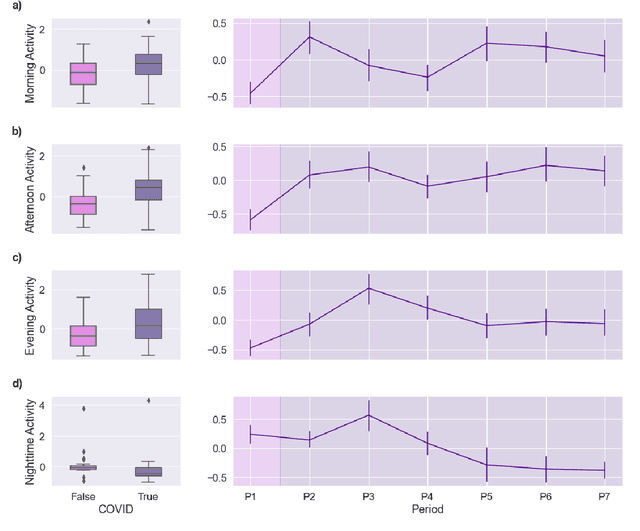
Abstract:Malnutrition and dehydration are strongly associated with increased cognitive and functional decline in people living with dementia (PLWD), as well as an increased rate of hospitalisations in comparison to their healthy counterparts. Extreme changes in eating and drinking behaviours can often lead to malnutrition and dehydration, accelerating the progression of cognitive and functional decline and resulting in a marked reduction in quality of life. Unfortunately, there are currently no established methods by which to objectively detect such changes. Here, we present the findings of an extensive quantitative analysis conducted on in-home monitoring data collected from 73 households of PLWD using Internet of Things technologies. The Coronavirus 2019 (COVID-19) pandemic has previously been shown to have dramatically altered the behavioural habits, particularly the eating and drinking habits, of PLWD. Using the COVID-19 pandemic as a natural experiment, we conducted linear mixed-effects modelling to examine changes in mean kitchen activity within a subset of 21 households of PLWD that were continuously monitored for 499 days. We report an observable increase in day-time kitchen activity and a significant decrease in night-time kitchen activity (t(147) = -2.90, p < 0.001). We further propose a novel analytical approach to detecting changes in behaviours of PLWD using Markov modelling applied to remote monitoring data as a proxy for behaviours that cannot be directly measured. Together, these results pave the way to introduce improvements into the monitoring of PLWD in naturalistic settings and for shifting from reactive to proactive care.
Designing A Clinically Applicable Deep Recurrent Model to Identify Neuropsychiatric Symptoms in People Living with Dementia Using In-Home Monitoring Data
Oct 19, 2021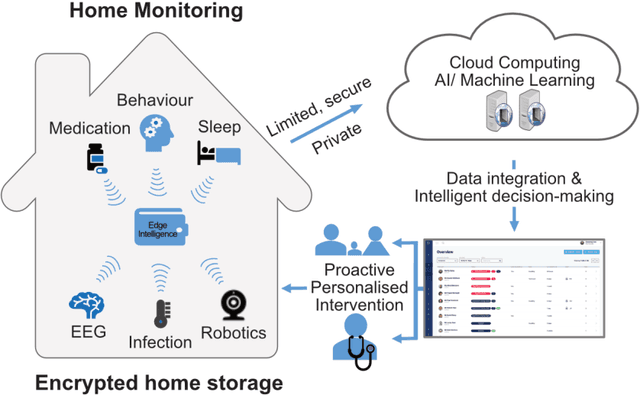
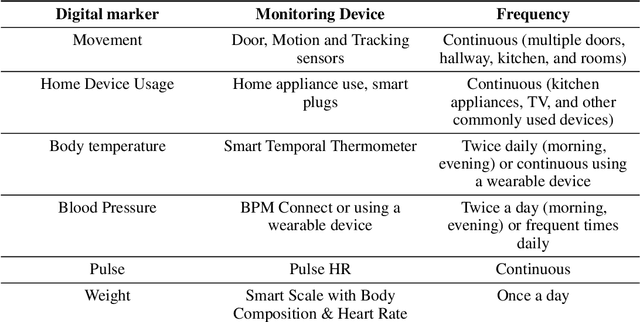

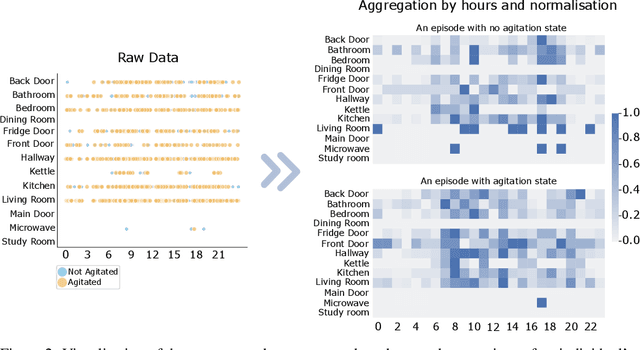
Abstract:Agitation is one of the neuropsychiatric symptoms with high prevalence in dementia which can negatively impact the Activities of Daily Living (ADL) and the independence of individuals. Detecting agitation episodes can assist in providing People Living with Dementia (PLWD) with early and timely interventions. Analysing agitation episodes will also help identify modifiable factors such as ambient temperature and sleep as possible components causing agitation in an individual. This preliminary study presents a supervised learning model to analyse the risk of agitation in PLWD using in-home monitoring data. The in-home monitoring data includes motion sensors, physiological measurements, and the use of kitchen appliances from 46 homes of PLWD between April 2019-June 2021. We apply a recurrent deep learning model to identify agitation episodes validated and recorded by a clinical monitoring team. We present the experiments to assess the efficacy of the proposed model. The proposed model achieves an average of 79.78% recall, 27.66% precision and 37.64% F1 scores when employing the optimal parameters, suggesting a good ability to recognise agitation events. We also discuss using machine learning models for analysing the behavioural patterns using continuous monitoring data and explore clinical applicability and the choices between sensitivity and specificity in-home monitoring applications.
Semi-supervised Learning for Identifying the Likelihood of Agitation in People with Dementia
May 14, 2021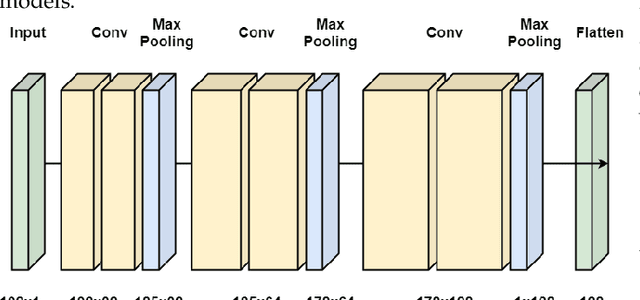

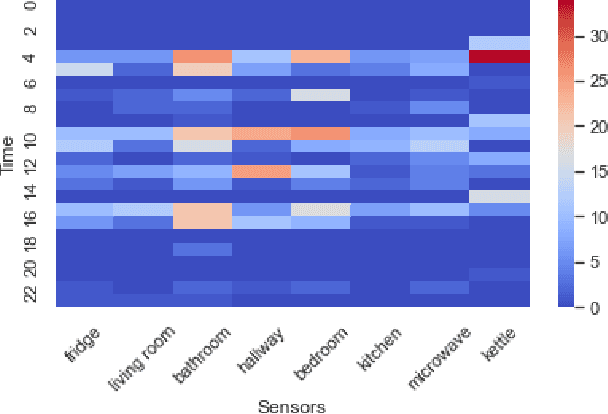
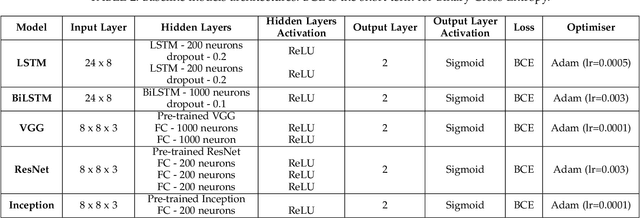
Abstract:Interpreting the environmental, behavioural and psychological data from in-home sensory observations and measurements can provide valuable insights into the health and well-being of individuals. Presents of neuropsychiatric and psychological symptoms in people with dementia have a significant impact on their well-being and disease prognosis. Agitation in people with dementia can be due to many reasons such as pain or discomfort, medical reasons such as side effects of a medicine, communication problems and environment. This paper discusses a model for analysing the risk of agitation in people with dementia and how in-home monitoring data can support them. We proposed a semi-supervised model which combines a self-supervised learning model and a Bayesian ensemble classification. We train and test the proposed model on a dataset from a clinical study. The dataset was collected from sensors deployed in 96 homes of patients with dementia. The proposed model outperforms the state-of-the-art models in recall and f1-score values by 20%. The model also indicates better generalisability compared to the baseline models.
An Intelligent Bed Sensor System for Non-Contact Respiratory Rate Monitoring
Mar 25, 2021



Abstract:We present an IoT-based intelligent bed sensor system that collects and analyses respiration-associated signals for unobtrusive monitoring in the home, hospitals and care units. A contactless device is used, which contains four load sensors mounted under the bed and one data processing unit (data logger). Various machine learning methods are applied to the data streamed from the data logger to detect the Respiratory Rate (RR). We have implemented Support Vector Machine (SVM) and also Neural Network (NN)-based pattern recognition methods, which are combined with either peak detection or Hilbert transform for robust RR calculation. Experimental results show that our methods could effectively extract RR using the data collected by contactless bed sensors. The proposed methods are robust to outliers and noise, which are caused by body movements. The monitoring system provides a flexible and scalable way for continuous and remote monitoring of sleep, movement and weight using the embedded sensors.
An attention model to analyse the risk of agitation and urinary tract infections in people with dementia
Jan 18, 2021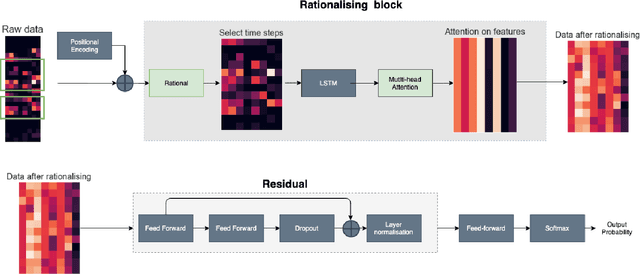
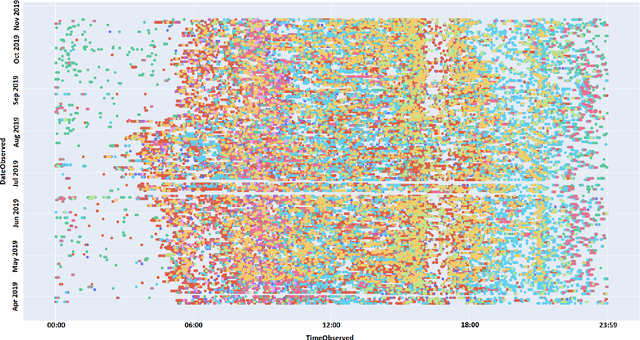
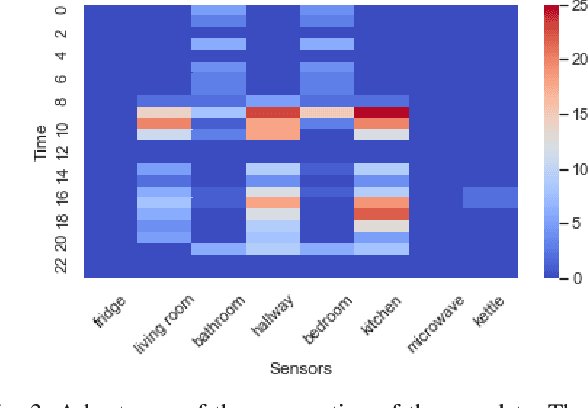
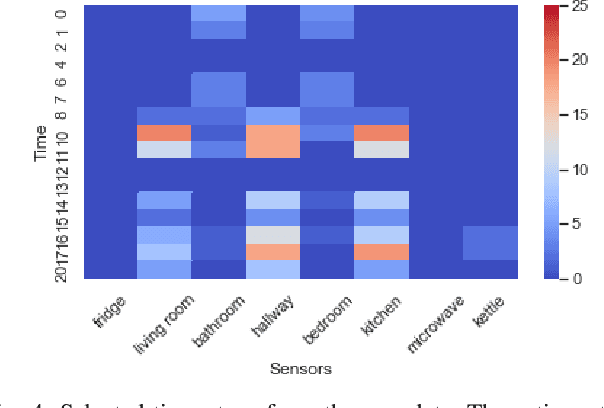
Abstract:Behavioural symptoms and urinary tract infections (UTI) are among the most common problems faced by people with dementia. One of the key challenges in the management of these conditions is early detection and timely intervention in order to reduce distress and avoid unplanned hospital admissions. Using in-home sensing technologies and machine learning models for sensor data integration and analysis provides opportunities to detect and predict clinically significant events and changes in health status. We have developed an integrated platform to collect in-home sensor data and performed an observational study to apply machine learning models for agitation and UTI risk analysis. We collected a large dataset from 88 participants with a mean age of 82 and a standard deviation of 6.5 (47 females and 41 males) to evaluate a new deep learning model that utilises attention and rational mechanism. The proposed solution can process a large volume of data over a period of time and extract significant patterns in a time-series data (i.e. attention) and use the extracted features and patterns to train risk analysis models (i.e. rational). The proposed model can explain the predictions by indicating which time-steps and features are used in a long series of time-series data. The model provides a recall of 91\% and precision of 83\% in detecting the risk of agitation and UTIs. This model can be used for early detection of conditions such as UTIs and managing of neuropsychiatric symptoms such as agitation in association with initial treatment and early intervention approaches. In our study we have developed a set of clinical pathways for early interventions using the alerts generated by the proposed model and a clinical monitoring team has been set up to use the platform and respond to the alerts according to the created intervention plans.
Machine learning for risk analysis of Urinary Tract Infection in people with dementia
Nov 27, 2020


Abstract:The Urinary Tract Infections (UTIs) are one of the top reasons for unplanned hospital admissions in people with dementia, and if detected early, they can be timely treated. However, the standard UTI diagnosis tests, e.g. urine tests, will be only taken if the patients are clinically suspected of having UTIs. This causes a delay in diagnosis and treatment of the conditions and in some cases like people with dementia, the symptoms can be difficult to observe. Delay in detection and treatment of dementia is one of the key reasons for unplanned hospital admissions in people with dementia. To address these issues, we have developed a technology-assisted monitoring system, which is a Class 1 medical device. The system uses off-the-shelf and low-cost in-home sensory devices to monitor environmental and physiological data of people with dementia within their own homes. We have designed a machine learning model to use the data and provide risk analysis for UTIs. We use a semi-supervised learning model which leverage the environmental data, i.e. the data collected from the motion sensors, smart plugs and network-connected body temperature monitoring devices in the home, to detect patterns that can show the risk of UTIs. Since the data is noisy and partially labelled, we combine the neural networks and probabilistic neural networks to train an auto-encoder, which is to extract the general representation of the data. We will demonstrate our smart home management by videos/online, and show how our model can pick up the UTI related patterns.
 Add to Chrome
Add to Chrome Add to Firefox
Add to Firefox Add to Edge
Add to Edge